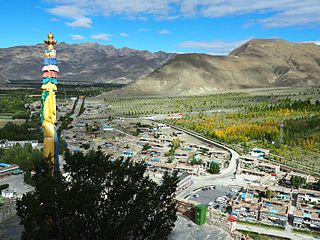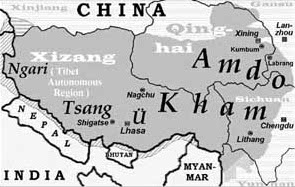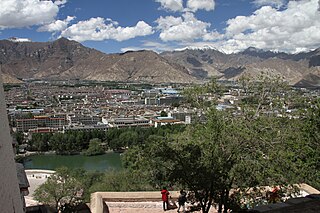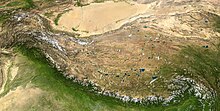
Tibet is a region in the central part of East Asia, covering much of the Tibetan Plateau and spanning about 2,500,000 km2 (970,000 sq mi). It is the homeland of the Tibetan people. Also resident on the plateau are some other ethnic groups such as the Monpa, Tamang, Qiang, Sherpa and Lhoba peoples and, since the 20th century, considerable numbers of Han Chinese and Hui settlers. Since the annexation of Tibet by the People's Republic of China in 1951, the entire plateau has been under the administration of the People's Republic of China. Tibet is divided administratively into the Tibet Autonomous Region, and parts of the Qinghai and Sichuan provinces. Tibet is also constitutionally claimed by the Republic of China as the Tibet Area since 1912.

The Tibet Autonomous Region or Xizang Autonomous Region, often shortened to Tibet or Xizang, is an autonomous region of the People's Republic of China in Southwest China. It was overlayed on the traditional Tibetan regions of Ü-Tsang and Kham.

Lhasa is the urban center of the prefecture-level Lhasa City and the administrative capital of Tibet Autonomous Region in southwest China. The inner urban area of Lhasa City is equivalent to the administrative borders of Chengguan District, which is part of the wider prefectural Lhasa City.

While the Tibetan plateau has been inhabited since pre-historic times, most of Tibet's history went unrecorded until the introduction of Tibetan Buddhism around the 6th century. Tibetan texts refer to the kingdom of Zhangzhung as the precursor of later Tibetan kingdoms and the originators of the Bon religion. While mythical accounts of early rulers of the Yarlung Dynasty exist, historical accounts begin with the introduction of Buddhism from India in the 6th century and the appearance of envoys from the unified Tibetan Empire in the 7th century. Following the dissolution of the empire and a period of fragmentation in the 9th-10th centuries, a Buddhist revival in the 10th–12th centuries saw the development of three of the four major schools of Tibetan Buddhism.

Nagqu is a prefecture-level city in the north of the Chinese autonomous region of Tibet. On May 7, 2018, the former Nagqu Prefecture was officially declared the sixth prefecture-level city in Tibet after Lhasa, Shigatse, Chamdo, Nyingchi and Shannan. The regional area, covering an area of 450,537 km2 (173,953 sq mi), is bordered by Bayingolin and Hotan Prefectures of Xinjiang to the north, Haixi, Yushu Prefectures of Qinghai and Chamdo to the east, Nyingchi, Lhasa and Shigatse to the south, Ngari Prefecture to the west. As of the 2010 census, it had a population of 462,381.

Shannan, also known as Lhoka, is a prefecture in the southeastern Tibet Autonomous Region, China. Shannan includes Gonggar County within its jurisdiction with Gongkar Chö Monastery, Gonggar Dzong, and Gonggar Airport all located near Gonggar town.

Mount Nyenchen Tanglha is the highest peak of Nyenchen Tanglha Mountains, which together with the Gangdise range forms the Transhimalaya.

Pome County or Bomê County is a county of Nyingchi Prefecture in the south-east of the Tibet Autonomous Region. Historically known as Powo or Poyul, it was the seat of a quasi-independent kingdom until the early 20th century when troops of the Dalai Lama's Lhasa government integrated it into the central Tibetan realm. The population was 25,897 in 2004.
This is a list of topics related to Tibet.

Namling County is a county of Shigatse in the Tibet Autonomous Region, China.

The Central Institute of Higher Tibetan Studies, formerly called Central University for Tibetan Studies (CUTS), is a Deemed University founded in Sarnath, Varanasi, India, in 1967, as an autonomous organisation under Union Ministry of Culture. The CIHTS was founded by Pt. Jawahar Lal Nehru in consultation with Tenzin Gyatso, the 14th Dalai Lama, with the aim of educating Tibetan youths in exile and Himalayan border students as well as with the aim of retranslating lost Indo-Buddhist Sanskrit texts that now existed only in Tibetan, into Sanskrit, to Hindi, and other modern Indian languages.

The 1959 Tibetan uprising began on 10 March 1959, when a revolt erupted in Lhasa, the capital of Tibet, which had been under the effective control of the People's Republic of China (PRC) since the Seventeen Point Agreement was reached in 1951. The initial uprising occurred amid general Chinese-Tibetan tensions and a context of confusion, because Tibetan protesters feared that the Chinese government might arrest the 14th Dalai Lama. The protests were also fueled by anti-Chinese sentiment and separatism. At first, the uprising mostly consisted of peaceful protests, but clashes quickly erupted and the Chinese People's Liberation Army (PLA) eventually used force to quell the protests, some of the protesters had captured arms. The last stages of the uprising included heavy fighting, with high civilian and military losses. The 14th Dalai Lama escaped from Lhasa, while the city was fully retaken by Chinese security forces on 23 March 1959. Thousands of Tibetans were killed during the 1959 uprising, but the exact number of deaths is disputed.

Tibet came under the control of People's Republic of China (PRC) after the Government of Tibet signed the Seventeen Point Agreement which the 14th Dalai Lama ratified on 24 October 1951, but later repudiated on the grounds that he had rendered his approval for the agreement while under duress. This occurred after attempts by the Tibetan Government to gain international recognition, efforts to modernize its military, negotiations between the Government of Tibet and the PRC, and a military conflict in the Chamdo area of western Kham in October 1950. The series of events came to be called the "Peaceful Liberation of Tibet" by the Chinese government, and the "Chinese invasion of Tibet" by the Central Tibetan Administration and the Tibetan diaspora.

Batang County is a county located in western Garzê Tibetan Autonomous Prefecture, Sichuan Province, China. The main administrative centre is known as Batang Town.

The Lhasa River, also called Kyi Chu, is a northern tributary of the Yarlung Tsangpo River in the south of the Tibet Autonomous Region of China. The Yarlung Tsangpo is the upper section of the Brahmaputra River. The Lhasa River is subject to flooding with the summer monsoon rains, and structures have been built to control the floods. In its lower reaches the river valley is an important agricultural area. The city of Lhasa, named after the river, lies on the river. There are two large hydroelectric power stations on the river, the Zhikong Hydro Power Station (100 MW) and the Pangduo Hydro Power Station (160 MW)

Ü is a geographic division and a historical region in Tibet. Together with Tsang, it forms Central Tibet Ü-Tsang, which is one of the three Tibetan regions or cholka. The other two cholka are Kham (Dotod) and Amdo (Domed). According to a Tibetan saying, "the best religion comes from Ü-Tsang, the best men from Kham, and the best horses from Amdo".

The Battle of Chamdo occurred from 6 to 24 October 1950. It was a military campaign by the People's Republic of China (PRC) to take the Chamdo Region from a de facto independent Tibetan state. The campaign resulted in the capture of Chamdo and the annexation of Tibet by the People's Republic of China.

The Tibet Area was a province-level administrative division of the Republic of China which consisted of Ü-Tsang and Ngari areas, but excluding the Amdo and Kham areas. However, the Republic of China never exercised control over the territory, which was ruled by the Ganden Phodrang government in Lhasa. The People's Republic of China, which overthrew the ROC on the mainland in 1949, invaded Chamdo in 1950 and incorporated the Dalai Lama-controlled regions in 1951. After the 1959 Tibetan rebellion, the State Council of the PRC ordered the replacement of the Tibetan Kashag government with the "Preparatory Committee for the Tibet Autonomous Region" (PCTAR). The current Tibet Autonomous Region was established as a province-level division of the People's Republic of China in 1965.

Tibet under Qing rule refers to the Qing dynasty's rule over Tibet from 1720 to 1912. The Qing rulers incorporated Tibet into the empire along with other Inner Asia territories, although the actual extent of the Qing dynasty's control over Tibet during this period has been the subject of political debate. The Qing called Tibet a fanbu, fanbang or fanshu, which has usually been translated as "vassal", "vassal state", or "borderlands", along with areas like Xinjiang and Mongolia. Like the preceding Yuan dynasty, the Manchus of the Qing dynasty exerted military and administrative control over Tibet, while granting it a degree of political autonomy.

Lhasa is a prefecture-level city, one of the main administrative divisions of the Tibet Autonomous Region of China. It covers an area of 29,274 square kilometres (11,303 sq mi) of rugged and sparsely populated terrain. Its urban center is Lhasa, with around 300,000 residents, which mostly corresponds with the administrative Chengguan District, while its suburbs extend into Doilungdêqên District and Dagzê District. The consolidated prefecture-level city contains additional five, mostly rural, counties.




















